

Exploring our past to sort out myth from reality
Share this Page on
Facebook or Twitter

These are the voyages of the TimeShip Anachron.
Our Mission: To boldly explore the past, dispelling
mythinformation and mythconceptions
of American History along the way.
 Visit us on Facebook
Visit us on Facebook
Meet MythAmerica Series

Pt 1 Pt 2 Pt 3 Pt 4 Pt 5 Pt 6 Pt 7 Pt 8 Pt 9
Terrorism on American Soil, Part 6
Cold Case File
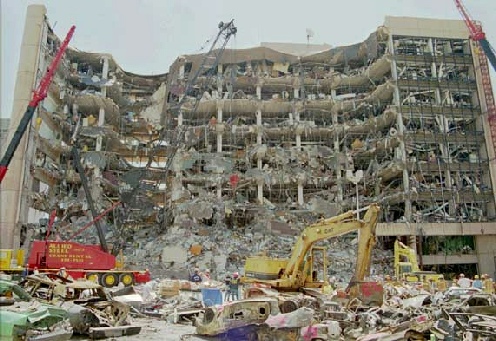
For many Oklahomans, there has never been a darker day than April 19, 1995. At two minutes past nine o’clock that morning, when the northern face of the Alfred P. Murrah Federal Building in downtown Oklahoma City was blown inward by the deadliest act of terrorism ever to take place on American soil, lives were shattered, lives were lost, and the history of the state would never again be the same.
One-
The Murrah Building bombing is, without any question, one of the great tragedies of Oklahoma history. And well before the last memorial service was held for the last victim, thousands of Oklahomans made it clear that they wanted what happened on that dark day to be remembered. For upon the chain-
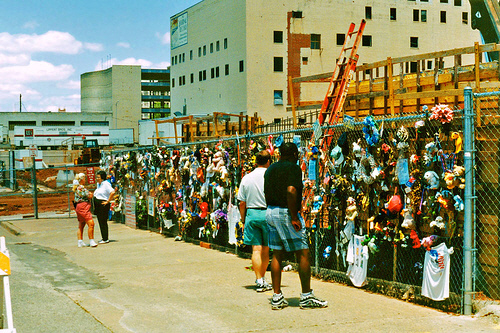
Now, with the construction and dedication of the Oklahoma City National Memorial, there is no doubt but that both the victims and the lessons of April 19, 1995 will not be forgotten. [Source: History Knows No Fences; this is the source for most of the quotations in this blog entry, except when otherwise noted. It will be abbreviated HKNF.]
Wikipedia describes the elaborate and expensive Memorial:
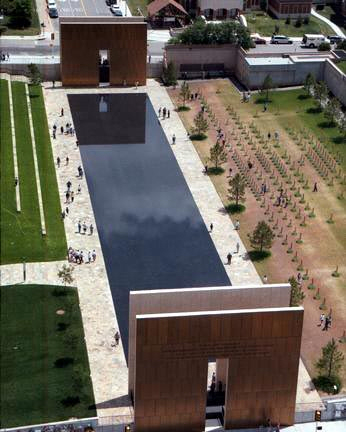
For two years after the bombing the only memorials to the victims were plush toys, crucifixes, letters, and other personal items left by thousands of people at a security fence surrounding the site of the building. [That fence, as seen below, was moved and is now part of the permanent memorial.]
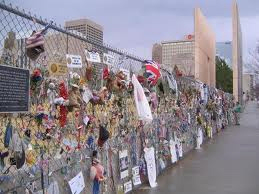
Many suggestions for suitable memorials were sent to Oklahoma City, but an official memorial planning committee was not set up until early 1996, when the Murrah Federal Building Memorial Task Force, composed of 350 members, was set up to formulate plans for a memorial to commemorate the victims of the bombing.On July 1, 1997 the winning design was chosen unanimously by a 15-
.. An observance is held each year to remember the victims of the bombing. An annual marathon draws thousands, and allows runners to sponsor a victim of the bombing. For the tenth anniversary of the bombing, the city held 24 days of activities, including a week-
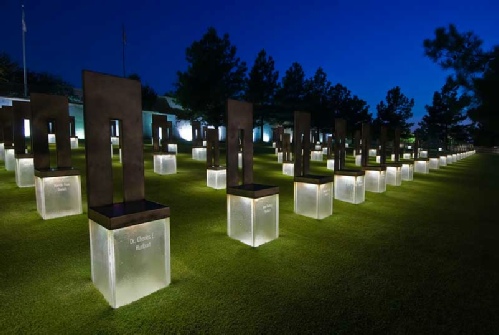
Vice President Dick Cheney, former president Clinton, Oklahoma Governor Brad Henry, Frank Keating, Governor of Oklahoma at the time of the bombing, and other political dignitaries attended the service and gave speeches in which they emphasized that “goodness overcame evil”. The relatives of the victims and the survivors of the blast also made note of it during the service at First United Methodist Church in Oklahoma City.
President George W. Bush made note of the anniversary in a written statement, part of which echoed his remarks on the execution of Timothy McVeigh in 2001: “For the survivors of the crime and for the families of the dead the pain goes on.”
Yes, the Oklahoma City bombing put Oklahoma “on the map” as one of the icons of American History from then on. It was allegedly the Ground Zero of the “first terrorist act on American soil.” And words at the Memorial site insist it must not and will not be forgotten.
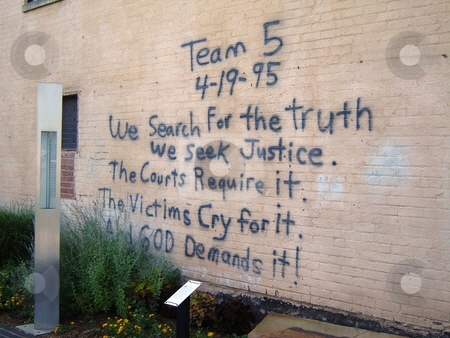

Of course, this Meet MythAmerica series has documented how the term “first terrorist act” for the Murrah disaster is a mis-
But what would have come as a surprise to most of the state’s citizens during the sad spring of 1995 was that there were, among them, other Oklahomans who carried within their hearts the painful memories of an equally dark, though long ignored, day in our past. For seventy-
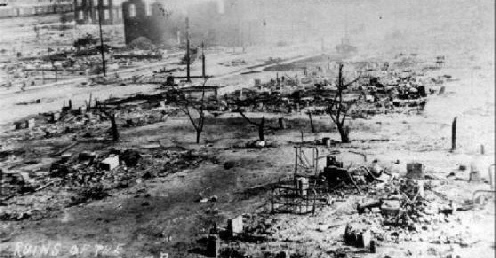
Not just one building went up in flames on that day, but 1,256 homes, a hospital, a library, a whole business district, and more. And likely as many or more people were injured or died that day (conservative estimates are close to 100 dead, some documentation indicates it may have been closer to 300, with numerous injured) as on the day of the Oklahoma City bombing.
By any standard, the Tulsa race riot of 1921 is one of the great tragedies of Oklahoma history. Walter White, one of the nation’s foremost experts on racial violence, who visited Tulsa during the week after the riot, was shocked by what had taken place. “I am able to state,” he said, “that the Tulsa riot, in sheer brutality and willful destruction of life and property, stands without parallel in America.”
But the aftermath of this act of terror and hatred yielded no “makeshift memorial of the heart — of teddy bears and handwritten children’s prayers, key rings and dreamcatchers, flowers and flags.” It merited no $29 million “memorial.” No presidential visits, no annual memorial marathon.
And, in fact, it didn’t even merit public mention locally or nationally, after the short burst of news reports at the time, for almost 75 years after the event. It was as if it had never happened. The protestations at the Oklahoma City Memorial that justice for such heinous acts is “required by the Courts, the Victims seek it, God demands it” ring hollow, for evidently justice is “required” for only a certain class of heinous acts.
For decades afterwards, Oklahoma newspapers rarely mentioned the riot, the state’s historical establishment essentially ignored it, and entire generations of Oklahoma school children were taught little or nothing about what had happened. To be sure, the riot was still a topic of conversation, particularly in Tulsa. But these discussions — whether among family or friends, in barber shops or on the front porch — were private affairs. And once the riot slipped from the headlines, its public memory also began to fade.
I suppose at least on the national “popular news media” level this was entirely understandable. Even today, yesterday’s “biggest news story ever” becomes “stale news” by next week. And thus it was with the Tulsa Holocaust. At first it was even an international story:
The riot, when it happened, was front-
But something else happened as well. For in the days and weeks that followed the riot, editorial writers from coast-
Of course it is logical that this news would quickly fade in New York and London as soon as other news stories of interest to the locals there became “hot.” But how—and why—was it seemingly so quickly forgotten even in Tulsa, where the skyline of “Black Wall Street,” of the community of Greenwood, which had been just down the street from Main Street Tulsa for many years, was suddenly gone? I guess the local view of the charred landscape of crumbling buildings and missing homes was somewhat like the proverbial “elephant in the room” that everyone knows is there, but all pretend it ISN’T.
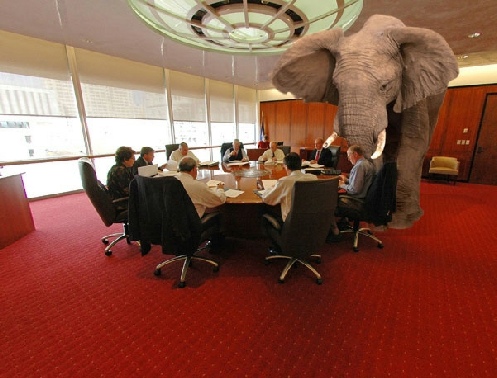
For many Oklahomans, and particularly for whites in positions of civic responsibility, such sentiments [as those expressed in the screaming headlines of June 1921] were most unwelcome. For regardless of what they felt personally about the riot, in a young state [statehood had come in 1907] where attracting new businesses and new settlers was a top priority, it soon became evident that the riot was a public relations nightmare. Nowhere was this felt more acutely than in Tulsa. “I suppose Tulsa will get a lot of unpleasant publicity from this affair,” wrote one Tulsa-
What is remarkable, in retrospect, is the degree to which this nearly happened.
… Nowhere was this historical amnesia more startling than in Tulsa itself, especially in the city’s white neighborhoods. “For a while,” noted former Tulsa oilman Osborn Campbell, “picture postcards of the victims in awful poses were sold on the streets,” while more than one white ex-
Part of it was that white Tulsans “passively” quit talking about it, hoping it would fade away on its own. This included the local paper:
During the mid-
Instead they listed “news stories” such as:
“FIFTEEN YEARS AGO
Miss Carolyn Skelly was a charming young hostess of the past week, having entertained at a luncheon and theater party for Miss Kathleen Sinclair and her guest, Miss Julia Morley of Saginaw, Mich. Corsage bouquets of Cecil roses and sweet peas were presented to the guests, who were Misses Claudine Miller, Martha Sharpe, Elizabeth Cook, Jane Robinson, Pauline Wood, Marie Constantin, Irene Buel, Thelma Kennedy, Ann Kennedy, Naomi Brown, Jane Wallace and Edith Smith.
…Central high school’s crowning social event of the term just closed was the senior prom in the gymnasium with about 200 guests in attendance. The grand march was led by Miss Sara Little and Seth Hughes.
Miss Vera Gwynne will leave next week for Chicago to enter the University of Chicago where she will take a course in kindergarten study.”
And by ten years later the amnesia was evidently complete.
Ten years later, in 1946, by which time the Tribune had added a “Twenty-
But the “circle of silence” wasn’t all exactly “passive”…
When Nancy Feldman moved to Tulsa during the spring of 1946, she had never heard of the Tulsa race riot. A Chicagoan, and a new bride, she accepted a position teaching sociology at the University of Tulsa. But trained in social work, she also began working with the City Health Department, where she came into contact with Robert Fairchild, a recreation specialist who was also one of Tulsa’s handful of African American municipal employees. A riot survivor, Fairchild told Feldman of his experiences during the disaster, which made a deep impression on the young sociologist, who decided to share her discovery with her students.
But as it turned out, Feldman also soon learned something else, namely, that learning about the riot, and teaching about it, were two entirely different propositions. “During my first months at TU,” she later recalled:
“I mentioned the race riot in class one day and was surprised at the universal surprise among my students. No one in this all-
“I invited Mr. Fairchild to come to class and tell of his experience, walking along the railroad tracks to Turley with his brothers and sister. Again, there was stout denial and, even more surprising, many students asked their parents and were told, no, there was no race riot at all. I was called to the Dean’s office and advised to drop the whole subject.”
“The next semester, I invited Mr. Fairchild to come to class. Several times the Dean warned me about this. I do not believe I ever suffered from this exercise of my freedom of speech . . . but as a very young and new instructor, I certainly felt threatened.”
For Feldman, such behavior amounted to nothing less than “Purposeful blindness and memory blocking.” Moreover, she discovered, it was not limited to the classroom. “When I would mention the riot to my white friends, few would talk about it. And they certainly didn’t want to.”
There were no doubt many incidents like this. Here’s one other:
When Nancy Dodson, a Kansas native who later taught at Tulsa Junior College, moved to Tulsa in 1950, she too discovered that, at least in some parts of the white community, the riot was a taboo subject. “I was admonished not to mention the riot almost upon our arrival,” she later recalled, “Because of shame, I thought. But the explanation was ‘you don’t want to start another.’ “
And on the more “official level” …
… during the summer of 1957, when the city celebrated its “Tulsarama” – a week-
As would be naturally expected, the discussion of the events never really died out among those remnants of Tulsa’s black population who decided to stay and try to rebuild some semblance of a black community in the old area where thriving Greenwood had once been. And over the years, there were efforts by independent researchers to tap into the memories of those folks, as well as dig into the paper trail of the 1921 event itself. They never got widespread attention for their work, but they did manage to amass an amazing collection of photos, interviews with survivors, and documentation from police, Red Cross, National Guard, and other records. A few scholarly papers and even a book or two were produced, but none that caught public attention.
Things began changing just a tiny bit in the 1950s and beyond.
For as the national debate over race relations intensified with the emergence of the modem civil rights movement of the 1950s and 1960s, Tulsa’s own racial customs were far from static. As the city began to address issues arising out of school desegregation, sit-
Few felt this as strongly as those who had survived the tragedy itself, and on the evening of June 1, 1971, dozens of African American riot survivors gathered at Mount Zion Baptist Church for a program commemorating the fiftieth anniversary of the riot. Led by W.D. Williams, a longtime Booker T. Washington High School history teacher, whose family had suffered immense property loss during the violence, the other speakers that evening included fellow riot survivors Mable B. Little, who had lost both her home and her beauty shop during the conflagration, and E.L. Goodwin, Sr., the publisher of the Oklahoma Eagle, the city’s black newspaper. Although the audience at the ceremony — which included a handful of whites — was not large, the event represented the first public acknowledgment of the riot in decades.
Yes, it took fifty years for even the tiniest squeak of a “public acknowledgment.” But even that was overshadowed by the continuing conspiracy of silence. Which took a nasty turn that same year, 1971.
But another episode that same spring also revealed just how far that Tulsa, when it came to owning up to the race riot, still had to go. The previous autumn, Larry Silvey, the publications manager at the Tulsa Chamber of Commerce, decided that on the fiftieth anniversary of the riot, the chamber’s magazine should run a story on what had happened. Silvey then contacted Ed Wheeler, the host of ‘The Gilcrease Story,” a popular history program which aired on local radio. Wheeler — who, like Silvey, was white – agreed to research and write the article. Thus, during the winter of 1970-
But something else happened as well. For on two separate occasions that winter, Wheeler was approached by white men, unknown to him, who warned him, “Don’t write that story.” Not long thereafter, Wheeler’s home telephone began ringing at all hours of the day and night, and one morning he awoke to find that someone had taken a bar of soap and scrawled across the front windshield of his car, “Best check under your hood from now on.”
But Ed Wheeler was a poor candidate for such scare tactics. A former United States Army infantry officer, the incidents only angered him. Moreover, he was now deep into trying to piece together the history of the riot, and was not about to be deterred. But to be on the safe side, he sent his wife and young son to live with his mother-
Despite the harassment, Wheeler completed his article and Larry Silvey was pleased with the results. However, when Silvey began to lay out the story — complete with never-
Determined that his efforts should not have been in vain, Wheeler then tried to take his story to Tulsa’s two daily newspapers, but was rebuffed.
So once again, “white Tulsa” was protected from having to face its ugly past. Wheeler finally got his major article published, but not by the white establishment.
In the end, his article — called “Profile of a Race Riot” — was published in Impact Magazine, a new, black-
This Don Ross was eventually to change the history of history in Tulsa. But it took another 25 years to pull that off.